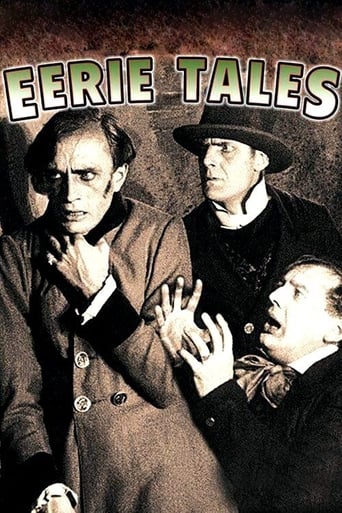Richard Chatten
By 1919 feature films were now long enough to accommodate more than just one story (as 'Intolerance' had amply demonstrated), and 'Unheimliche Geschichten' provides five; replete with spooky special effects and atmospherically lit interiors shot by Carl Hoffmann that make good use of depth of field. (The apprehensive-looking fellow who appears in the prologue with Reinhold Schunzel and Conrad Veidt is director Richard Oswald.) 'The Black Cat' and 'The Suicide Club' (episodes 3 and 4) will already be familiar to most viewers, while the first episode presumably draws upon the same urban legend that originated during the Paris Exposition of 1889 that was most famously filmed as 'So Long at the Fair' in 1950. I don't know how widely seen this film was during the 20's, but plenty of the imagery found its way into later, more famous movies (the ghostly clutching hand in 'The Beast with Five Fingers', the button that can kill the person sitting in a particular chair at the reading of SPECTRE's financial reports in 'Thunderball', for example).With his creepy demeanour, slicked-back hair and tights, moon-faced Reinhold Schunzel as Satan resembles The Riddler, while in the first episode he looks like Kurt Raab. It's always good to see Conrad Veidt; but the film is particularly valuable as a record of the naughty Weimar-era cabaret dancer Anita Berber, whose adoption of formal male attire in 'Dr Mabuse' was later made famous by her erstwhile girlfriend Marlene Dietrich, and who was the subject of a famous portrait by Otto Dix in 1925. She burned herself out young but here gets ample opportunity to display her worldly presence in several different roles, as well as her famous androgyny and dancing agility doing the splits in tights and a short smock that display her legs while simultaneously making her resemble a female Hamlet.
Klaus Ming
Unheimliche Geschichten is an anthology of five short "Uncanny Stories" read by Death, the Devil and the Harlot who step out of three life sized paintings in an old bookstore after closing. Though really none of these tales are very frightening, Conrad Veidt's menacing looks and dramatic performances in each, undoubtedly helped him secure the role of Caesar in The Cabinet of Doctor Caligari (1920). Oswald's use of the anthology format may also be the earliest in the history of the horror genre of cinema.
Zbigniew_Krycsiwiki
"Richard Oswald's "Eerie Tales" debuted with a length of 2318 metres, July 16, 1920, after a premiere on November 6, 1919. The original negative is considered lost. This restoration is from Cinematheque Francaise. The film currently has a length of 2230 metres."Paintings of Death, the devil, and a prostitute come to life in a bookstore, after hours, and read each other five tales of horror, to amuse themselves, in this early anthology film.Each of the three leads take on different roles in each of the five stories, giving each actor an opportunity to show a wide range, and the film has a good look to it, plus I've always had a certain affinity for anthology horrors, but the problem with this is that it's not scary. I was hoping for a bit more fright for my 31 Days of Halloween horror. Die Erscheinung, by Anselma Heine, and Poe's Die Schwarze Katze were the best of the segments, while the rest were overly dramatic.
jshoaf
An aspect of this film that amused me was that four out of the five stories involve romantic triangles of one sort or another. A man picks up a woman who cries on his shoulder, and pretty soon he's kissing her in her bedroom, though he is pushed out because she has a headache (oops, the plague). Two men decide that the girl who has left them at a club to dance with somebody else must belong to one of them, so they throw dice for her; she is surprised to find one of them lying on her couch when she comes home and not pleased that he's a corpse; when she meets the other a few years later, they seem ready to take up where they left off. A drunkard takes a stranger home to his wife and within 30 seconds the stranger is kissing the wife (Conrad Veidt gets to do all the kissing in this movie). A wise French marquis encourages his wife to snuggle up to an amorous stranger, then shows her that he himself is a much better snuggle. All this (plus another story) in a version that only lasted about 95 minutes.Because the segments are so short, each seduction takes at most a few minutes. There is no time for anyone to be sentimental or even fall in love--it's lust at first sight in every case. True, usually someone in the story dies before fornication or adultery can be committed. But there is something about the galloping pace that brings the horror--the deaths, the hauntings--right up against the sexy parts in a balder way that is usual in the early horror movies I've seen.The film is fun because each actor gets to play a wide range of characters. Reinhold Schunzel particularly gets to play a crazy sadistic brute, a sly drunken brute, a jealous but gentlemanly brute, a masterful cop, and a charming but cowardly 18th-century marquis. Anita Berber has a scene in which she (or a double? there was more costume around her head than around her legs) performs a fairly lengthy piece of modern dance--this character is a proto-flapper, but she also does quiet little 19th-c American wife and "the Strumpet" with great energy and sweetness. Veidt--well, as I said, he is the guys who get to the kissing as fast as possible in 4 of the stories, and a sadistic monster in the fifth. Who could ask for more?



